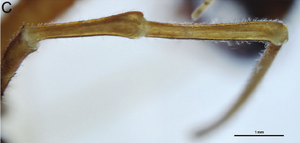| Forsteropsalis bona | |
|---|---|
 Forsteropsalis bona Taylor & Probert, 2014 Dorsal view (from original description) | |
|
Suborder |
|
|
Superfamily |
|
|
Family |
|
|
Subfamily |
|
|
Genus |
|
Forsteropsalis bona Taylor & Probert, 2014 is a member of the genus Forsteropsalis (Eupnoi:Neopilionidae).
Taxonomy[]
- F.b. Taylor & Probert, 2014:39[1]
Specimens[]
- F.b. male(1) (holotype) Museum of New Zealand Te Papa Tongarewa, Wellington, New Zealand; #[1]
- F.b. male(2) (paratypes) Museum of New Zealand Te Papa Tongarewa, Wellington, New Zealand; #[1]
- F.b. male(1) (paratype) New Zealand Arthropod Collection, Landcare Research, Auckland, New Zealand; #[1]
Diagnosis[]
(from Taylor & Probert, 2014[1])
- Total body length 4.8–6.6; prosoma length 2.5–2.8, width 4.0–4.2. Prosoma (including ocularium) unarmed (Fig. 1A); ground colour in alcohol orangebrown with longitudinal yellow stripes on either side of ocularium (live coloration very dark brown [almost black] with orange-yellow stripes; appendages also black). Ozopores elongate, with small flanking lobes. Opisthosoma grey-yellow. Mouthparts cream-coloured; medial side of pedipalpal coxa with dense array of sharp denticles; cervix unarmed. Coxae yellow.
- Chelicerae (Fig. 1B): Segment I length 6.2–8.4; segment II 9.4–10.4. Elongate; segment I orange with lighter yellow patch at distal end, segment II dark orange-brown. Segment I denticulate, with denticles concentrated along dorsal, proventral and retroventral margins. Segment II massively inflated, evenly denticulate. Cheliceral fingers elongate, widely bowed apart; setae present on distal half of mobile finger.
- Pedipalps: Femur length 5.4–5.7; patella 2.2–2.4; tibia 2.8–3.1; tarsus 5.8–6.5. Distinctly elongate, yellow. Femur dorsally denticulate on proximal two-thirds; remainder of pedipalp unarmed. Setae sparse except for small concentration at prodistal end of patella; microtrichia present on tarsus and distal half of tibia; prodorsal end of patella with distinct protrusion but without definite finger-like apophysis (Fig. 1C). Tarsal claw without ventral tooth-row.
- Legs: Legs I femur length 8.6–9.9, patella 1.9–2.5, tibia 8.3–9.8; leg II femur 14.3–17.2, patella 2.2–2.8, tibia 14.4–17.8; leg III femur 7.5–8.7, patella 1.7–2.3, tibia 5.3–8.2; leg IV femur 8.5–10.7, patella 1.8–2.7, tibia 10.2–10.8. Femora sparsely denticulate, particularly in proximal half; remainder of legs unarmed. Distitarsus I with strong ventral tooth at distal end of each of first five or six pseudosegments (Fig. 1D). Tibia II with nine to fifteen pseudosegments; tibia IV with two pseudosegments.
- Penis (Fig. 1E–F): Shaft subquadrate; tendon long. Bristle groups relatively long, posterior bristle group with longest bristles reaching dorsal margin in lateral view. Glans short, subtriangular in ventral view, narrowing rapidly in lateral view.
Notes[]
Literature[]
- Taylor & Probert, 2014[1]
Additional images - Gallery[]
Proximal pseudosegments of right distitarsus I (venter upwards), showing ventrodistal teeth (from original description)
References[]
| Eupnoi Classification |
|---|
| Incertae sedis | ||
|---|---|---|
| Not assigned to any family | †Brigantibunum | †Daohugopilio | †Macrogyion | Hesperopilio | |
| Superfamily Caddoidea | ||
|---|---|---|
| Family Caddidae | Caddo | |





